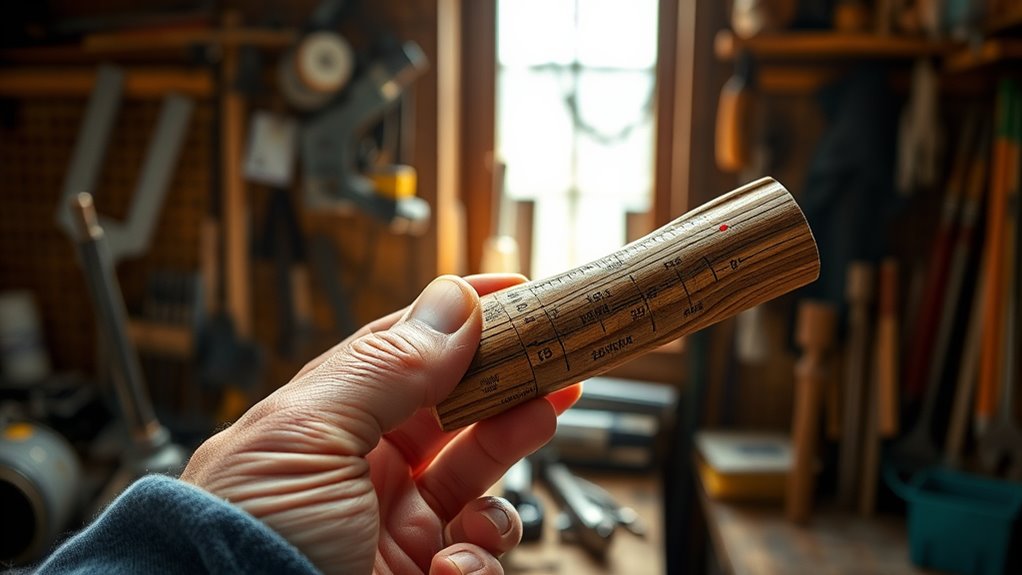To avoid measuring mistakes with the story stick methodology, use a physical reference like a stick or rod to create clear, consistent measurement markers. This tangible tool diminishes human errors, prevents guesswork, and helps you double-check measurements visually. By aligning the stick directly with your target, you ensure accuracy every time. Staying mindful of these practices improves precision and saves time. Keep exploring to learn how this simple method can transform your measurement process.
Key Takeaways
- Use a consistent physical reference, like a story stick, to standardize measurements and reduce misreading errors.
- Align the stick carefully with the measurement target to ensure precise and repeatable results.
- Double-check measurements visually against the stick to catch and correct errors immediately.
- Train team members to use the story stick properly, maintaining uniform measurement procedures.
- Record measurements promptly and accurately with the physical reference to prevent misinterpretation or data loss.

Measuring accurately is vital to guaranteeing the success of any project, but mistakes happen when you rush or overlook details. To avoid costly errors, you need a reliable method for data collection and metric selection that keeps your measurements precise and consistent. The story stick methodology offers a simple yet effective way to do this, especially when working with physical measurements or tactile data. It’s a technique rooted in using a physical reference—like a stick or rod—to mark and compare measurements directly, reducing ambiguity and human error.
When you rely solely on digital tools or estimations, it’s easy to misread data or select inappropriate metrics that don’t truly reflect what you’re trying to measure. With the story stick method, you create a tangible, visual reference point that helps you stay consistent. For example, if you’re measuring lengths or distances, you cut or mark your stick to the exact size needed. This way, every time you need to measure, you simply align your stick with the object, guaranteeing your data collection is accurate. It eliminates guesswork and minimizes the chances of misreading or misremembering measurements.
Selecting the right metric is just as vital as collecting accurate data. When you choose a metric that aligns with your goals, it becomes easier to interpret results and make informed decisions. The story stick helps you focus on the specific measurement you need, avoiding the temptation to include irrelevant data. Instead of juggling multiple tools or relying on vague visual estimates, you have a precise reference that you can quickly and repeatedly use. This consistency in metric selection prevents skewed data and enhances the reliability of your project outcomes.
Moreover, the simplicity of the story stick methodology encourages you to double-check your measurements. Since you can physically see and compare your data against the reference, it’s easier to spot discrepancies early. This hands-on approach fosters a more mindful and deliberate measurement process. When you combine this with disciplined data collection practices—like recording measurements immediately and in a standardized manner—you considerably reduce mistakes. The physical nature of the story stick also makes it easier to train team members, ensuring everyone follows the same measurement protocol.
In addition, understanding the importance of consistent measurement tools can significantly improve your data accuracy, especially when working with physical objects. When you incorporate the story stick method, you create a simple, tangible system that minimizes human error, guarantees consistency, and ultimately leads to better project results. When you adopt this approach, you’ll find that measuring accurately becomes more natural, precise, and less prone to mistakes—saving you time, resources, and frustration in the long run.
Frequently Asked Questions
How Does Story Stick Methodology Compare to Digital Measurement Tools?
When comparing story stick methodology to digital measurement tools, you find that story sticks excel in capturing qualitative insights through visual storytelling. You actively engage with stories, gaining a deeper understanding of audience reactions and emotions that numbers alone can’t reveal. While digital tools provide quantitative data, story sticks help you interpret the context behind those numbers, making your insights richer and more actionable.
Can Story Stick Techniques Be Applied in Remote or Virtual Teams?
You can definitely adapt story stick techniques for remote or virtual teams, enhancing virtual collaboration. By using physical props or shared storytelling tools during video calls, you foster engagement and clear communication. Remote adaptation helps team members connect more deeply, making the storytelling process interactive and personal. This approach bridges distance gaps, encourages participation, and strengthens team cohesion, ensuring your team effectively utilizes story stick methods even in a virtual environment.
What Industries Benefit Most From Using Story Stick Measurement?
Did you know 78% of construction projects encounter measurement errors? You’ll find story stick measurement especially useful in construction accuracy and event planning. It helps you visualize progress and catch mistakes early. By applying this method, you guarantee precise measurements, reduce costly errors, and streamline workflows. Whether building structures or organizing events, story sticks make complex measurements tangible, keeping your projects on track and within budget.
How Do You Train Teams to Effectively Use Story Stick Methodology?
To train your teams effectively, start with engaging training workshops that focus on the fundamentals of story stick methodology. Encourage hands-on practice and real-world scenarios to build confidence. Incorporate feedback loops where team members share experiences and lessons learned. This continuous cycle helps refine skills and guarantees consistent application. By fostering open communication and ongoing learning, your team will master the technique and improve measurement accuracy over time.
Are There Limitations or Challenges in Implementing Story Stick Measurement?
When implementing story stick measurement, you may face practical limitations like inconsistent storytelling or unclear criteria, which can skew results. Cultural challenges also arise if team members aren’t comfortable sharing openly or if storytelling isn’t ingrained in your organization’s practices. These issues can hinder accurate measurement and alignment. To overcome them, foster open communication, provide clear guidelines, and encourage a culture that values honest storytelling for better results.
Conclusion
Think of your project like a delicate tapestry—you’re weaving each thread with care. Using the story stick methodology keeps your measurements precise, preventing costly mistakes and unraveling. When you trust this simple yet powerful tool, you’re guiding your work with the steady hand of a master weaver. Avoiding measurement errors isn’t just about accuracy; it’s about creating something beautiful and enduring. Stay mindful, stay precise, and watch your masterpiece come to life without unnecessary tears.









